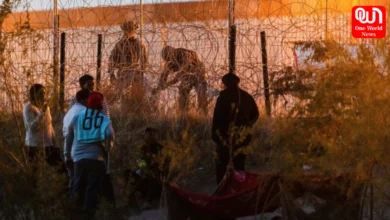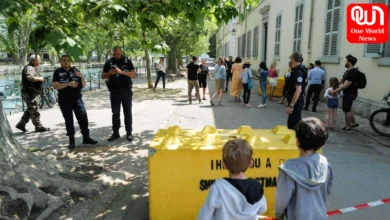Unanswered Questions Regarding the Mossad Intelligence Failure and the Ongoing Israel-Hamas Conflict
In the midst of a devastating conflict between Israel and Hamas that has claimed thousands of lives, one burning question lingers: Did Israel’s intelligence service, Mossad, fail to foresee the unprecedented terror attack launched by Hamas, or was it part of a larger conspiracy?
The ongoing war, which has now entered its fourth week, has left more than 8,000 people dead, according to Gaza’s health ministry.
The doubts surrounding Mossad’s effectiveness arise from the agency’s stellar reputation as the most efficient, extensive, and well-funded intelligence network in the World. With an annual budget of $3 billion and a staff of 7,000, Mossad is second in size only to the CIA among Western espionage agencies.
Its track record for successfully thwarting external threats has been nearly impeccable, making the failure to anticipate the Hamas attack all the more perplexing. Hamas’s ability to stockpile thousands of rockets and missiles in close proximity to Israeli territory without detection by Israeli intelligence has raised critical questions. Furthermore, the apparent inability of Israel’s highly reliable Iron Dome missile defense system to intercept all incoming projectiles from Gaza adds to the mystery. The scale, complexity, and extensive planning required for the attack have left experts pondering how and why Israel’s renowned intelligence agency missed it.
In a telling move on September 22, 2023, Israeli Prime Minister Benjamin Netanyahu presented a map titled “The New Middle East” at the U.N. General Assembly, marking a section of the region in green, encompassing all of Israel without delineations for occupied Palestinian territory, and extending into neighboring countries such as Egypt, Saudi Arabia, Bahrain, and the United Arab Emirates. Many geopolitical leaders view this as a significant indicator of the expected result of the ongoing conflict between Hamas and Israel.
Not surprisingly, US officials have also come out strongly in favor of Israel. As the conflict rages on, the questions surrounding Mossad’s supposed failure to foresee the Hamas attack persist, leaving room for speculation about the broader implications and motivations behind this intelligence lapse.
History of War:
In order to understand the current war between Israel and Palestine, we have to first look back into the history of the location and the people associated with it. The history of the conflict between Hamas and Israel can be traced back to the decline and dissolution of the Ottoman Empire, which ruled the region until the end of World War I.
Fall of Ottoman Empire :
The Ottoman Empire, one of the most powerful and longest-lasting empires in history, fell primarily as a result of a combination of internal and external weaknesses. Beginning in the late 16th century, the empire faced a gradual erosion of its strength, evidenced by repeated failed attempts to conquer Vienna and subsequent territorial losses, including the relinquishment of Hungary in 1699.
Corruption and internal decay plagued the Ottoman government, contributing to its weakening over time. The late 17th and 18th centuries witnessed the Empire’s involvement in conflicts such as the Russo-Turkish Wars and with Austria and Poland, further undermining its stability and influence. By the 19th century, the Ottoman Empire had earned the sobriquet “the sick man of Europe,” highlighting its diminished stature and waning power in international affairs.
The Ottomans’ alignment with Germany during World War I proved to be a pivotal moment in its downfall. The repercussions of the war led to the dissolution of their Empire through postwar treaties. As a last nail in its coffin, in 1922, Mustafa Kemal Atatürk abolished the sultanate, marking the end of the Ottoman Monarchy.
Origin and Evolution of Zionism :
However, the late 19th and early 20th centuries witnessed the rise of the Zionist movement, an ideological and political force propelled by the desire to establish a Jewish national homeland. This movement gained momentum against the backdrop of rising anti-Semitism in Europe and a deep desire among Jewish communities for a home of their own. The movement’s focus on the ancient land of Palestine, which was under Ottoman control, intensified as it sought to establish a Jewish state on historical and religious grounds. The ancient allure of Palestine, with its links to Jewish history and heritage, served as a compelling focal point for the Zionist movement’s aspirations.
Britisher’s Control over Palestine :
As the Ottoman Empire grappled with internal weaknesses and external pressures, its hold on the region gradually weakened, setting the stage for a transformational shift in power dynamics. The British, through the mechanisms of the League of Nations mandate system, assumed control over Palestine.
It was during this pivotal moment that the Balfour Declaration of 1917, a statement of British support for the establishment of a “national home for the Jewish people” in Palestine, reverberated across the global stage, as the Christian powers that be were actually relieved to get rid of the Jews from their lands once and for all. This declaration, while promising to uphold the rights of the non-Jewish communities in the region, sparked intense debates and disputes over the future of Palestine.
The ramifications of the Balfour Declaration were far-reaching and complex, as the declaration’s ambiguous language and promises served to stoke the fires of both hope and apprehension among the various communities residing in the region. It became a cornerstone in the foundation of the Israeli-Palestinian conflict, as competing visions of identity, sovereignty, and historical narratives clashed, engendering a struggle that persists to this day.
Creation of Palestine :
During that era, there was a significant increase in Jewish immigration to Palestine, driven by the Zionist movement’s desire for a Jewish homeland.
In 1947, amid rising tensions and competing national aspirations, the United Nations proposed partitioning Palestine into separate Jewish and Arab states. While Jewish leaders accepted the proposal, Arab leaders, including those in the Palestinian territories, rejected it, causing the 1948 Arab-Israeli War. The war resulted in the establishment of the State of Israel as well as the displacement of a large number of Palestinians, resulting in the formation of Palestinian refugee populations. Various entities, including Egypt and, later, Israel, have taken control of Palestinian territories, including the Gaza Strip, over time.
In the late twentieth century, the Palestinian Liberation Organization (PLO) emerged as a prominent representative of the Palestinian national movement, advocating for establishing an independent Palestinian state. In the midst of internal Palestinian political dynamics, Hamas, a Muslim Brotherhood offshoot, rose to prominence in the late 1980s, incidentally, aided and abetted by Israel, challenging the PLO’s authority and eventually gaining control of the Gaza Strip in 2007 after a brief and violent clash with Fatah, the PLO’s leading faction.
However, the establishment of Israel triggered a complex and long-lasting conflict with the Palestinian people, who had a strong attachment to the land and saw the establishment of Israel as a violation of their rights and sovereignty. This conflict has since evolved into the Israeli-Palestinian conflict, which is characterized by disputes over territory, refugees, and the status of Jerusalem, among other contentious issues, shaping the Middle East’s geopolitical landscape and posing ongoing challenges to regional peace and stability.
How Does the Conflict Begin? (Recent One)
The whole Conflict began on the 7th of October when, Hundreds of Hamas gunmen breached the heavily fortified perimeter fence, crossing from the Gaza Strip into southern Israel. This audacious breach was executed through a combination of tactics, including breaking through the fence, making a sea landing, and even employing paragliders. Notably, this marked one of the most serious cross-border attacks Israel had encountered in over a generation.
The situation further escalated due to a history of hostilities, with Hamas previously being responsible for various attacks in Israel. These attacks targeted significant locations such as Tel Aviv, Jerusalem, Haifa, Ashkelon, Ashdod, Sderot, and other areas within Israeli territory. The methods employed ranged from rocket launches to suicide bombings and other forms of violence, resulting in casualties and substantial damage in these regions.
The breach of the perimeter fence on October 7th was a significant catalyst for the recent surge in hostilities, leading to a full-scale conflict that has had severe repercussions for both sides involved.
In an unexpected turn of events, questions are being raised about the recent alleged attempt by Hamas to breach Israel’s heavily fortified perimeter fence. As tensions rise, the world waits with bated breath for answers to these perplexing questions.
Read more:- Israel-Hamas War: UN Urges Gaza Humanitarian Ceasefire
Furthermore, the failure of Mossad’s intelligence apparatus to detect and thwart the Hamas attempt has raised questions about the Larger Conspiracy. How could Mossad, which is known for its impeccable track record in intelligence and covert operations, overlook such a significant breach? The world anxiously awaits an explanation, which will as we know, be difficult to come by, especially, given its ramifications.
Finally, and perhaps most intriguingly, could there be hidden ways of communication or collaboration between the two seemingly opposing factions? As the world tries to understand the underlying dynamics, more questions than answers emerge.
The mystery is heightened by the revelation that Hamas obtained a large quantity of Weapons during their alleged attack. There are numerous theories and speculations, but concrete answers remain elusive.
Israel behind the Creation of Hamas :
Did you know that Israel helped to turn a group of Palestinian Islamists into one of the militant groups (Hamas) in the late 1970s?
According to the report of The Intercept, the creation of Hamas was largely influenced by resources provided by Israel. The Intercept article reads, “This isn’t a conspiracy theory.”
The article quotes Israeli officials, including Brig. Gen. Yitzhak Segev, a former military governor of Gaza. Segev reportedly stated his role in financially assisting the Palestinian Islamist movement, seeing it as a “counterweight” to the secularist Palestine Liberation Organization and the Fatah party, led by Yasser Arafat (who himself referred to Hamas as “a creature of Israel.”)
“The Israeli government gave me a budget,” Segev admitted to a reporter for the New York Times, “and the military government gives to the mosques.”
Avner Cohen, a former Israeli official who worked in religious affairs in Gaza for over two decades, told the Wall Street Journal, “Hamas, to my great regret, is Israel’s creation.”
According to The Intercept, Cohen even wrote an official report to his superiors in the mid-1980s warning them not to play divide-and-rule in the Occupied Territories by supporting Palestinian Islamists against Palestinian secularists.
“I … suggest focusing our efforts on finding ways to break up this monster before this reality jumps in our face,” he wrote in an email.
The acknowledgment of Israel’s role in the formation of Hamas has sparked internal conspiracy theories and prompted a rethinking of the historical context in which this militant group formed. This revelation is sure to spark a lot of interest and debate in the coming days.
According to the report of Firstpost, Israel helped Sheikh Ahmed Yassin and company to weaken the PLO and Yasser Arafat ( Chief of PLO at that time ). Then Yasin created a group called Mujama, Israel recognized this group and they too allowed him to create the Islamic University of Gaza. In 1984, Israel realized its mistake and arrested Yasin, they found him storing Weapons. In 1985, Yassin walked out of jail, and in 1987, he formed Hamas.
Many Former commanders of Israel had also expressed regret for this. One Israeli Commander admitted to Funding Hamas himself, Palki stated in Firstpost.
Comparison with the Gleiwitz Incident:
Certainly, some leaders and analysts are drawing comparisons between the recent incident and the historical Gleiwitz incident, which took place as a trigger to World War II, a stage-managed by the Hitler Regime to expand German territory.
The way, The Gleiwitz incident was a staged attack carried out by Nazi Germany on the night of August 31, 1939, near the town of Gleiwitz, which was then part of Germany. The attack was planned and carried out by the SS (Schutzstaffel) as part of Operation Himmler. The objective of this operation was to create a false justification for an invasion of Poland, which would eventually lead to the outbreak of World War II. As part of the operation, German forces posed as Polish soldiers attacked a German radio station in Gleiwitz. They planted the bodies of political prisoners at the scene to create the impression that Polish forces had seized the station. The attackers also broadcast an anti-German message in Polish, further implicating Poland in the staged attack.
The Gleiwitz incident, along with other staged incidents, provided the Nazi regime with a pretext to invade Poland on September 1, 1939. Following this invasion, the United Kingdom and France, which had guaranteed Poland’s security, declared war on Germany on September 3, 1939, kicking off World War II.
By manipulating the narrative through planted evidence and staged attacks, Hitler sought to create a facade of Polish aggression, thereby providing a purported rationale for the military campaign that would inevitably trigger a global conflict.
Read more:- Israel News: Netanyahu Warns Hezbollah Against Joining War With Hamas
The invasion of Poland was the direct cause of the start of World War II, helped along by the manufactured circumstances and the well-planned excuse of the Gleiwitz incident. Following their declarations of war against Germany, the United States, France, and the United Kingdom sparked a global struggle that resulted in unimaginable death tolls and devastation.
Hitler’s expansionist goals and his unrelenting quest for domination and power not only caused unimaginable pain to countless people but also ushered in a period of unprecedented turmoil and destruction over the globe.
Analysts are currently looking into the possibility of a conspiracy linked to the recent attack. They are concentrating their efforts on figuring out the source of the explosives and weaponry that facilitated the breach of the advanced “smart wall” and border defenses. Notably, the breach occurred despite the presence of military and intelligence units trained to rely on cutting-edge cameras and sensors to monitor border activities and alert ground forces immediately in the event of any suspicious or unusual occurrences.
Chillingly, the systematic ‘ethnic cleansing’ being carried out by Israel over the past few decades, culminating in the recent violence in Palestine, exceeds any moral justification for the acts of genocide committed in the last few days and shows no signs of abating. These actions are reminiscent of the horrors unleashed by the Nazis under Hitler on the same Jewish community, which ironically has now become the perpetrator.
This ‘cleansing act’ aligns with Zionist philosophy, and the revelation of a Palestine-free map of an expanded Israel by the Israeli President at the UN, supposedly triggered by a massive intelligence failure, strongly supports the theory of collusion for financial gain between some top Hamas leadership, possibly residing abroad, inadvertently assisting Israel in achieving their objectives sooner rather than later.
Liked this post?
Register at One World News to never miss out on videos, celeb interviews, and best reads.









